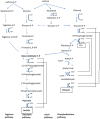Lactic acid bacteria as starter cultures: An update in their metabolism and genetics
- PMID: 31294241
- PMCID: PMC6613329
- DOI: 10.3934/microbiol.2018.4.665
Lactic acid bacteria as starter cultures: An update in their metabolism and genetics
Abstract
Lactic acid bacteria (LAB) are members of an heterogenous group of bacteria which plays a significant role in a variety of fermentation processes. The general description of the bacteria included in the group is gram-positive, non-sporing, non-respiring cocci or rods. An overview of the genetics of lactococci, Streptococcus thermophilus, lactobacilli, pediococci, leuconostocs, enterococci and oenococciis presented with special reference to their metabolic traits. The three main pathways in which LAB are involved in the manufacture of fermented foods and the development of their flavour, are (a) glycolysis (fermentation of sugars), (b) lipolysis (degradation of fat) and (c) proteolysis (degradation of proteins). Although the major metabolic action is the production of lactic acid from the fermentation of carbohydrates, that is, the acidification of the food, LAB are involved in the production of many beneficial compounds such as organic acids, polyols, exopolysaccharides and antimicrobial compounds, and thus have a great number of applications in the food industry (i.e. starter cultures). With the advances in the genetics, molecular biology, physiology, and biochemistry and the reveal and publication of the complete genome sequence of a great number of LAB, new insights and applications for these bacteria have appeared and a variety of commercial starter, functional, bio-protective and probiotic cultures with desirable properties have marketed.
Keywords: applications; fermented food; genetics; lactic acid bacteria.
Conflict of interest statement
Conflict of interest: The authors declare no conflict of interest.
Figures
Similar articles
-
Streptococcus thermophilus growth in soya milk: Sucrose consumption, nitrogen metabolism, soya protein hydrolysis and role of the cell-wall protease PrtS.Int J Food Microbiol. 2020 Dec 16;335:108903. doi: 10.1016/j.ijfoodmicro.2020.108903. Epub 2020 Oct 8. Int J Food Microbiol. 2020. PMID: 33065381
-
Beneficial features of pediococcus: from starter cultures and inhibitory activities to probiotic benefits.World J Microbiol Biotechnol. 2022 Nov 8;39(1):4. doi: 10.1007/s11274-022-03419-w. World J Microbiol Biotechnol. 2022. PMID: 36344843 Free PMC article. Review.
-
From gene to function: metabolic traits of starter cultures for improved quality of cereal foods.Int J Food Microbiol. 2009 Aug 31;134(1-2):29-36. doi: 10.1016/j.ijfoodmicro.2009.05.018. Epub 2009 May 22. Int J Food Microbiol. 2009. PMID: 19515445 Review.
-
[Development of fermented milk product based on mare milk and lactic microorganisms association].Vopr Pitan. 2021;90(5):115-125. doi: 10.33029/0042-8833-2021-90-5-115-125. Epub 2021 Sep 1. Vopr Pitan. 2021. PMID: 34719149 Russian.
-
Biogenic Amine Production by Lactic Acid Bacteria: A Review.Foods. 2019 Jan 7;8(1):17. doi: 10.3390/foods8010017. Foods. 2019. PMID: 30621071 Free PMC article. Review.
Cited by
-
Investigation of in situ and ex situ mode of lactic acid bacteria incorporation and the effect on dough extensibility, bread texture and flavor quality during shelf-life.Food Chem X. 2024 Sep 26;24:101857. doi: 10.1016/j.fochx.2024.101857. eCollection 2024 Dec 30. Food Chem X. 2024. PMID: 39483357 Free PMC article.
-
Milk Fat Globules: 2024 Updates.Newborn (Clarksville). 2024 Jan-Mar;3(1):19-37. doi: 10.5005/jp-journals-11002-0085. Epub 2024 Mar 26. Newborn (Clarksville). 2024. PMID: 39474586 Free PMC article.
-
Comprehensive Review of Aflatoxin and Ochratoxin A Dynamics: Emergence, Toxicological Impact, and Advanced Control Strategies.Foods. 2024 Jun 18;13(12):1920. doi: 10.3390/foods13121920. Foods. 2024. PMID: 38928866 Free PMC article. Review.
-
Lactic Acid Bacteria and Bacteriocins: Novel Biotechnological Approach for Biopreservation of Meat and Meat Products.Microorganisms. 2022 Oct 18;10(10):2058. doi: 10.3390/microorganisms10102058. Microorganisms. 2022. PMID: 36296334 Free PMC article. Review.
-
Screening of Wild Lactic Acid Bacteria from Algerian Traditional Cheeses and Goat Butter to Develop a New Probiotic Starter Culture.Probiotics Antimicrob Proteins. 2023 Apr;15(2):387-399. doi: 10.1007/s12602-022-10000-2. Epub 2022 Oct 29. Probiotics Antimicrob Proteins. 2023. PMID: 36307627
References
-
- Bintsis T. Lactic acid bacteria: their applications in foods. J Bacteriol Mycol. 2018;5:1065.
-
- Hayek SA, Ibrahim SA. Current limitations and challenges with lactic acid bacteria: a review. Food Nutr Sci. 2013;4:73–87.
-
- Khalid K. An overview of lactic acid bacteria. Int J Biosci. 2011;1:1–13.
-
- Bintsis T, Athanasoulas A. Dairy starter cultures. In: Papademas P, editor. Dairy Microbiology, A Practical Approach. Boca Raton: CRC Press; 2015. pp. 114–154.
-
- Von Wright A, Axelsson L. Lactic acid bacteria: An introduction. In: Lahtinne S, Salminen S, Von Wright A, et al., editors. Lactic Acid Bacteria: Microbiological and Functional Aspects. London: CRC Press; 2011. pp. 1–17.
Publication types
LinkOut - more resources
Full Text Sources
Other Literature Sources
Miscellaneous



